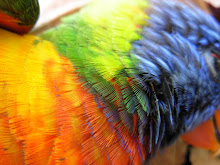The Balyet and the coming of the spring
Balyets 25th September 2008
Balyets...some say are invisible beings.
I read somewhere where the balyet was a woman who had lost her child. The woman died from the loss of her child and became a spirit - a wirreny. And with every child she found straying from its camp she would embrace, only to find that every child she embraced had died and her cry, the echo, was her anguish filled scream.
And I wonder what this story was meant to identify for the Noongar?? What message were the old ones trying to instill in successive generations?
Did this woman, old balyet, did she hold the child too close, only to smother it?? Did she love it too much??
And yet this story, ancient in its telling, is not singularly the providence of myth but the substance of belief, of experience.
Sure there is something that moves with the wind, something lonely, watching... waiting.
I have walked the trail to Hovea Falls through all sorts of rocky areas...and I am convinced I have been therein watched... but, likewise I have been watching too, listening... for the koooo!!! waiting for the signal, its cry.
Somewhere among the rocks I have heard them scurrying, jumping.
"Was that a wallaby or a maamara??" I am thinking in my mind.
I dare not speak...I try to allow instinct to direct me, let my senses react the way they should...
And all the while that little black and white bird I sense is watching, following, feasting off the gnats and bugs that my boots reveal.
Every boot-laden step, awakens and reveals all matter of slaters and centipedes who are upended and everywhere birds are watching.
Silver eyes in their blossoms feeding on nectar - watching. Wattle birds - warbling for the wet, all matter of birds are watching, and some watching my steps and in the distance you can hear them calling, conversing with each other high in the branches.
In the distance, sometimes, old man crow is calling to his yok - his one of several wives: "Has he been past your way yet?" "Is he carrying any food?" And then the lookout, the sentry somewhere who sits ever alert, signals with a piercing whistle. It signals the imminent arrival of sharpening talons and of marauding beak.
All fall silent.
The telegraph line of bird-speak is seldom ignored.
All fall silent and still to listen...
Then dark eyes hurtle by with the black falcon on reconnaissance hunting for the unaware, the deaf, the ignorant.
I see her pass me by.
Her eyes dark and searching.
We hold each other's stare, for a moment.
My stare for her is but wonder, awe, her stare for me... unknown...
Then, just as quickly, the whistle, that signal returns, the sign of the 'all clear' is given and it travels and follows that black falcon in its wake.
And everywhere there is movement and the sounds of feathered conversations returning to the surrounding paperbarks and tea tree.
I don't know how they do it, how they know to keep watch to keep listening.
Like them, I guess we humans have our satellites and spies.
When that falcon flies in, and we, unsuspectingly catch just a glimpse, then you have to take your hat off to the birds who have outwitted the falcon.
When I am walking to Hovea Falls, when wandering along that track, whilst I might call myself attentive, I am very often far from that.
The sweet nectar-laden scent of the paper bark and underbrush has me swaying.
Drunk... with my mind awash, my senses are anything but attuned and tuning.
The sound of rapids eddying in the foam-making flow of froth catches my ear.
So too is my sight enamoured to the froth caught in the straining and stirring hands of the stream side sink of tea tree.
I am distracted, too distracted to take in the eyes that are watching me and their sounds...
Was that a balyet or a wallaby??
There is just too much to take in.
And that maamara half-hidden in the rocks, scurrying in its clefts of rock in its hidden caves it calls home.
Mostly, but not always, I fail to see them.
Their stench is covered by the nectar honey-laden scents that spring has had a hand in stirring.
The dugite which moves from its burrow, moves hidden, olive green for the juvenile and brown black for the parent.
It is lost in the new grass.
Mice cannot see them but they are there.
Mice like we humans are focusing on the feast at hand.
Too focused on the feast than on that which might wish to make a feast of them.
All around us in spring are the eyes of watching feast dwellers.
When we humans walk such trails, we forget we have entered the food chain of others. Sure, we are hunters, but eyes watch us for the food possibilities we offer.
That the balyet spends her time looking for her lost child and the food possibilities is mostly lost to us...
Old stories are there for those who want to know them, but most don't care.
Why the willy wagtail moves and follows the movement of ground dwellers especially those she calls food, revealed by our footwear we very rarely see.
But that the willy wagtail might be the balyet in disguise we have never thought...or that the sweet nectar-filled scent of the underbrush might hide the scent of the maamara most had never once considered.
All of these scents hide the unsuspected or the hunter in the food chain.
But balyets are invisible how could we even know to see them??
They're invisible aren't they??
And that silence, that presence returns melding the unseen with the felt.
We are clothed in silence or that shadow hidden in the rocks.
And we know it, we are watched.

